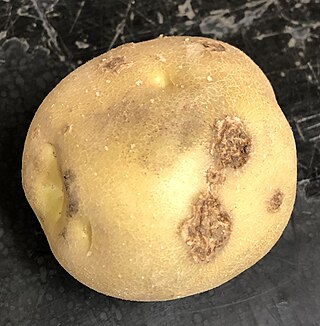
Streptomyces is the largest genus of Actinomycetota, and the type genus of the family Streptomycetaceae. Over 700 species of Streptomyces bacteria have been described. As with the other Actinomycetota, streptomycetes are gram-positive, and have very large genomes with high GC content. Found predominantly in soil and decaying vegetation, most streptomycetes produce spores, and are noted for their distinct "earthy" odor that results from production of a volatile metabolite, geosmin. Different strains of the same species may colonize very diverse environments.

The 15th Pan-American Games were held in Rio de Janeiro, Brazil, between 13 July 2007 and 29 July 2007. The Brazilian delegation consisted of 659 athletes and 267 directors, making a total of 926 people in 41 sports. Competing in their own country, the Brazilian athletes managed to far surpass their own record number of Gold, Silver and Bronze medals obtained in a single edition of the Pan-American Games.

Brannerion is an extinct genus of prehistoric marine bonefish. Fossils of the genus were found in the Romualdo Formation of the Santana Group, Araripe Basin, northeastern Brazil. It is considered a basal member of the Albuliformes.
Streptomyces scabiei is a streptomycete bacterium species found in soils around the world. Unlike most of the 500 or so Streptomyces species it is a plant pathogen causing corky lesions to form on tuber and root crops as well as decreasing the growth of seedlings. Along with other closely related species it causes the potato disease common scab, which is an economically important disease in many potato growing areas. It was first described in 1892, being classified as a fungus, before being renamed in 1914 and again in 1948. Several other species of Streptomyces cause similar diseases to S. scabiei but other, more closely related species, do not.
Casos e Acasos is a series of Brazilian TV Globo Network, written by Daniel Adjafre and Marcius Melhem, the general direction of Carlos Milan core of Marcos Schechtman and Jayme Monjardim. First aired as a special year-end on December 26, 2007, the program went live April 3, 2008 and no longer appears in the following year.
Faça Sua História is a TV series of Brazilian TV Globo Network, aired from April to December 2008. The series pilot was led by Stepan Nercessian, aired on December 27, 2007. Later on 6 April 2008 the series debuted with Vladimir Brichta as the protagonist Oswald.

Common scab is a plant disease of root and tuber crops caused by a small number of Streptomyces species, specifically S. scabies, S. acidiscabies, S. turgidiscabies and others. Common scab mainly affects potato, but can also cause disease on radish, parsnip, beet, and carrot. This plant disease is found wherever these vegetables are grown.

Bintje is a middle-early ripening potato variety bred in the Netherlands by the Frisian schoolmaster K.L. de Vries in 1904 from and marketed for the first time in 1910. The name of the potato, a diminutive of Benedict, was borrowed from one of his former students.
Streptomyces europaeiscabiei or is a streptomycete bacterium species that is associated with common scab in potatoes. Its type strain is CFBP 4497T.
Streptomyces stelliscabiei or is a streptomycete bacterium species that is associated with common scab in potatoes. Its type strain is CFBP 4521T.
Streptomyces reticuliscabiei is a streptomycete bacterium species that is associated with netted scab in potatoes. Its type strain is CFBP 4517T. It is considered to be part of a cluster together with S. turgidiscabies, however they cause different diseases, the former involved in common scab.
Streptomyces acidiscabies is a streptomycete bacterium species, causing a scab disease of potatoes. Its type strain is RL-110.
Streptomyces malaysiensis is a streptomycete bacterium species. At maturity, the aerial hyphae of this species differentiates into tight, spiral chains of rugose, cylindrical spores. Its type strain is ATB-11T.
Streptomyces turgidiscabies is a streptomycete bacterium species, causing scab in potatoes. It has flexuous spore, the latter which are cylindrical and smooth. The type strain is SY9113T. It is almost identical to Streptomyces reticuliscabiei; however, they are considered distinct species given the diseases they cause are different.
Streptomyces puniciscabiei is a streptomycete bacterium species known to cause potato common scab disease in Korea. Its type strain is S77T. It has purple-red, spiny spores that are borne in simple rectus flexuous spore-chains.
Streptomyces niveiscabiei is a streptomycete bacterium species known to cause potato common scab disease in Korea. Its type strain is S78T. It has white, smooth, cylindrical spores that are borne in simple rectus flexuous spore-chains.
Streptomyces microflavus is a bacterium species from the genus of Streptomyces which has been isolated from soil. Streptomyces microflavus produces nemadectin, fattiviracin A1, milbemycin and deoxyuridines. Streptomyces microflavus also produces the ionophore valinomycin. Streptomyces microflavus is also known to cause potato common scab disease in Korea.
Marmoricola aquaticus is a bacterium from the genus Marmoricola which has been isolated from the sponge Glodia corticostylifera in Sao Paulo, Brazil.
Streptomyces hilarionis is a species of aerobic Gram-positive actinomycete. It was discovered and characterized in Brazil, along with Streptomyces haiashii, where it has been associated with common scab, a disease that causes significant damage to potato crops worldwide. Its type strain is IBSBF 2807T.
Streptomyces brasiliscabiei is a streptomycete bacterium species that is associated with common scab in potatoes characterized in Brazil. Its type strain is IBSBF 2867T.




